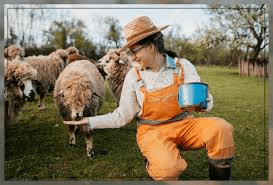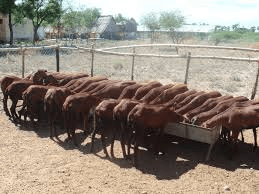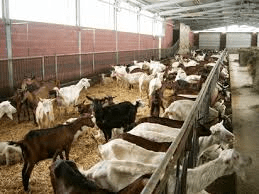Husbandry practices refer to the methods and techniques used in the care, breeding, and management of animals, particularly livestock. These practices are crucial for ensuring the well-being of animals, maximizing productivity, and maintaining a sustainable farming system.
Whether you’re raising cattle, poultry, or any other livestock, understanding and applying good husbandry practices is essential for success in animal farming.
Types of Animal Husbandry
Animal husbandry can be divided into different types based on the kind of animals being raised and their purposes. Here are some of the main types:
1. Dairy Farming: This involves the breeding and raising of dairy cattle primarily for milk production. Dairy farms must focus on nutrition, milking processes, and health management to ensure high-quality milk.
2. Poultry Farming: Poultry farming is the practice of raising birds such as chickens, ducks, and turkeys for their eggs and meat. Good husbandry in poultry farming includes providing proper feed, water, and shelter while managing diseases.
3. Beef Cattle Farming: Beef cattle are raised specifically for meat production. This type of farming focuses on feeding practices that promote muscle growth and managing breeding to produce high-quality beef.
4. Sheep and Goat Farming: Sheep and goats are raised for their meat, milk, and wool. Husbandry practices include proper grazing management, shearing, and disease control.
5. Aquaculture: This is the farming of fish, crustaceans, and other aquatic organisms. Proper water quality management, feeding, and disease prevention are key aspects of successful aquaculture.
Best Practices for Animal Nutrition

Nutrition plays a vital role in animal husbandry as it directly impacts the health, growth, and productivity of livestock. Here are the best practices for ensuring proper nutrition:
1. Balanced Diet: Animals require a balanced diet that includes the right mix of proteins, carbohydrates, fats, vitamins, and minerals. For example, dairy cows need a diet rich in proteins and energy to produce milk efficiently.
2. Quality Feed: Use high-quality feed to ensure that animals get all the nutrients they need. This includes selecting the right type of feed for the specific animal and its stage of development. For example, young animals might require more protein to support growth.
3. Supplementation: In some cases, animals may need supplements to meet their nutritional needs. For example, grazing animals might require mineral supplements to prevent deficiencies.
4. Water Supply: Provide clean and adequate water at all times. Water is crucial for digestion, nutrient absorption, and overall health.
5. Feeding Schedule: Establish a regular feeding schedule to keep animals healthy and productive. This helps maintain a consistent intake of nutrients and prevents digestive issues.
Breeding Techniques in Animal Husbandry
Breeding is an essential component of animal husbandry that determines the quality and productivity of livestock. Here are some common breeding techniques:
1. Natural Mating: This is the most traditional method where males and females are allowed to mate naturally. It’s important to select healthy and strong animals for breeding to ensure good offspring.
2. Artificial Insemination (AI): AI is a modern technique where semen is collected from a male and manually inserted into the female’s reproductive tract. This method allows for selective breeding and reduces the risk of transmitting diseases.
3. Crossbreeding: Crossbreeding involves mating animals of different breeds to combine desirable traits from both parents. This can lead to offspring that are more robust, disease-resistant, or productive.
4. Inbreeding and Linebreeding: Inbreeding involves mating closely related animals, while linebreeding is a milder form of inbreeding. These techniques are used to preserve specific traits in a lineage but must be managed carefully to avoid genetic defects.
5. Embryo Transfer: This advanced technique involves fertilizing eggs from a female animal in a lab and then implanting the embryos into a surrogate mother. This method is used to quickly multiply animals with superior genetics.
Read Also: 15 Medicinal Health Benefits of Salvia yangii (Russian Sage)
Animal Health and Disease Management

Keeping animals healthy is a top priority in animal husbandry. Here are key practices for managing animal health and preventing diseases:
1. Vaccination: Regular vaccination helps prevent common diseases. Make sure to follow the recommended vaccination schedule for each type of livestock.
2. Parasite Control: Internal and external parasites can harm livestock health and productivity. Use dewormers, insecticides, and other treatments to control parasites.
3. Quarantine New Animals: When introducing new animals to your farm, quarantine them for a period to ensure they are not carrying diseases that could spread to the rest of the herd.
4. Cleanliness: Maintain a clean environment by regularly cleaning barns, coops, and other areas where animals live. This helps prevent the spread of diseases.
5. Regular Health Checks: Conduct regular health checks to identify and treat any illnesses early. Work with a veterinarian to develop a health management plan for your animals.
Housing and Shelter for Livestock
Providing proper housing and shelter is crucial for the well-being and productivity of livestock. Here are best practices for housing and shelter:
1. Adequate Space: Ensure that livestock have enough space to move around comfortably. Overcrowding can lead to stress and increase the risk of disease.
2. Ventilation: Good ventilation is essential to remove moisture and gases like ammonia from animal housing. This helps prevent respiratory problems and keeps animals comfortable.
3. Temperature Control: Depending on the climate, provide heating or cooling to maintain a comfortable temperature for the animals. For example, in cold climates, barns should be insulated to keep animals warm.
4. Bedding: Provide clean and dry bedding to keep animals comfortable and prevent diseases like foot rot. Bedding materials can include straw, wood shavings, or sand.
5. Protection from Predators: Ensure that livestock housing is secure and protected from predators. This includes fencing and locking doors or gates to keep animals safe.
Read Also: Apple Maggot: Description, Damages Caused, Control and Preventive Measures
Sustainable Farming Practices

Sustainable farming practices are methods that focus on producing food and other agricultural products in a way that does not harm the environment, supports the well-being of animals, and promotes long-term agricultural productivity. Here are key practices in sustainable animal husbandry:
1. Rotational Grazing: Rotational grazing involves moving livestock between pastures to prevent overgrazing. This practice allows grasses to recover, improves soil health, and reduces the need for chemical fertilizers.
2. Integrated Pest Management (IPM): IPM uses a combination of biological, physical, and chemical methods to control pests in a way that minimizes harm to the environment and non-target organisms.
3. Water Conservation: Implementing water-saving techniques, such as rainwater harvesting and efficient irrigation systems, helps reduce water usage in farming operations, ensuring that this vital resource is used sustainably.
4. Organic Farming: Organic farming avoids the use of synthetic pesticides, fertilizers, and antibiotics. It promotes natural farming methods that improve soil fertility and animal health, contributing to overall sustainability.
5. Agroforestry: This practice involves integrating trees and shrubs into livestock farming systems. Agroforestry can enhance biodiversity, provide shade and shelter for animals, and improve the overall health of the ecosystem.
Animal Welfare and Ethical Considerations
Animal welfare is an essential aspect of husbandry practices, focusing on the humane treatment of animals. Ethical considerations in animal husbandry involve ensuring that animals are treated with respect and care. Key practices include:
1. Humane Handling: Animals should be handled gently and with care to reduce stress and prevent injuries. This includes using proper handling equipment and techniques.
2. Adequate Living Conditions: Animals should have enough space to move, rest, and engage in natural behaviors. Overcrowded conditions can lead to stress and health problems.
3. Freedom from Pain and Suffering: Animals should be protected from unnecessary pain and suffering. This includes providing prompt medical care and ensuring that slaughtering practices are humane.
4. Social Interaction: Many animals are social creatures and benefit from interaction with other animals. Providing opportunities for socialization can improve their overall well-being.
5. Ethical Breeding: Breeding practices should prioritize the health and well-being of animals, avoiding practices that lead to genetic disorders or other health issues.
Technological Advancements in Husbandry
Technology is transforming animal husbandry by improving efficiency, productivity, and animal welfare. Here are some of the technological advancements making a difference:
1. Precision Farming: Precision farming uses technology like GPS, sensors, and drones to monitor and manage livestock more efficiently. This can lead to better resource management and improved animal care.
2. Automated Feeding Systems: Automated feeders can ensure that animals receive the right amount of feed at the right times, improving nutrition and reducing waste.
3. Health Monitoring Devices: Wearable technology and sensors can monitor animals’ health in real-time, detecting issues early and allowing for prompt intervention.
4. Genetic Engineering: Advances in genetic engineering are allowing for the development of livestock with improved traits, such as disease resistance or enhanced productivity.
5. Artificial Intelligence (AI): AI is being used to analyze data from farms, predict outcomes, and make recommendations for improving animal husbandry practices.
Challenges and Solutions in Animal Husbandry
Animal husbandry faces several challenges, but there are also effective solutions to address these issues:
1. Disease Management: One of the biggest challenges is managing diseases that can affect livestock. Solutions include regular vaccinations, biosecurity measures, and early detection through health monitoring systems.
2. Climate Change: Changing weather patterns can impact feed availability, water resources, and animal health. Farmers can adopt climate-resilient practices such as drought-resistant crops, efficient water use, and providing adequate shelter to protect animals from extreme weather.
3. Resource Scarcity: Limited availability of land, water, and feed can constrain livestock farming. Solutions include sustainable resource management, such as rotational grazing, water conservation techniques, and using alternative feed sources.
4. Market Fluctuations: Farmers often face unpredictable market conditions that can affect their income. Diversifying income sources, such as by adding value to products or exploring niche markets, can help mitigate this risk.
5. Ethical Concerns: Addressing ethical concerns related to animal welfare and environmental impact is crucial. Implementing humane handling practices, ensuring good living conditions, and adopting sustainable farming methods can address these concerns.
Conclusion
Animal husbandry is a complex and vital component of agriculture that requires a balance between productivity, sustainability, and ethical considerations. By adopting sustainable farming practices, prioritizing animal welfare, and leveraging technological advancements, farmers can enhance their operations while promoting the health and well-being of their livestock.
Addressing the challenges in animal husbandry requires a proactive approach, including disease management, resource conservation, and ethical breeding practices. By focusing on these areas, farmers can ensure a sustainable and profitable future for their farming operations.
Overall, understanding and implementing best practices in animal husbandry not only benefits the animals but also contributes to the long-term success of farming, supporting food security and economic stability.
Read Also: How to Grow Microgreens
Frequently Asked Questions
We will update this section soon.

